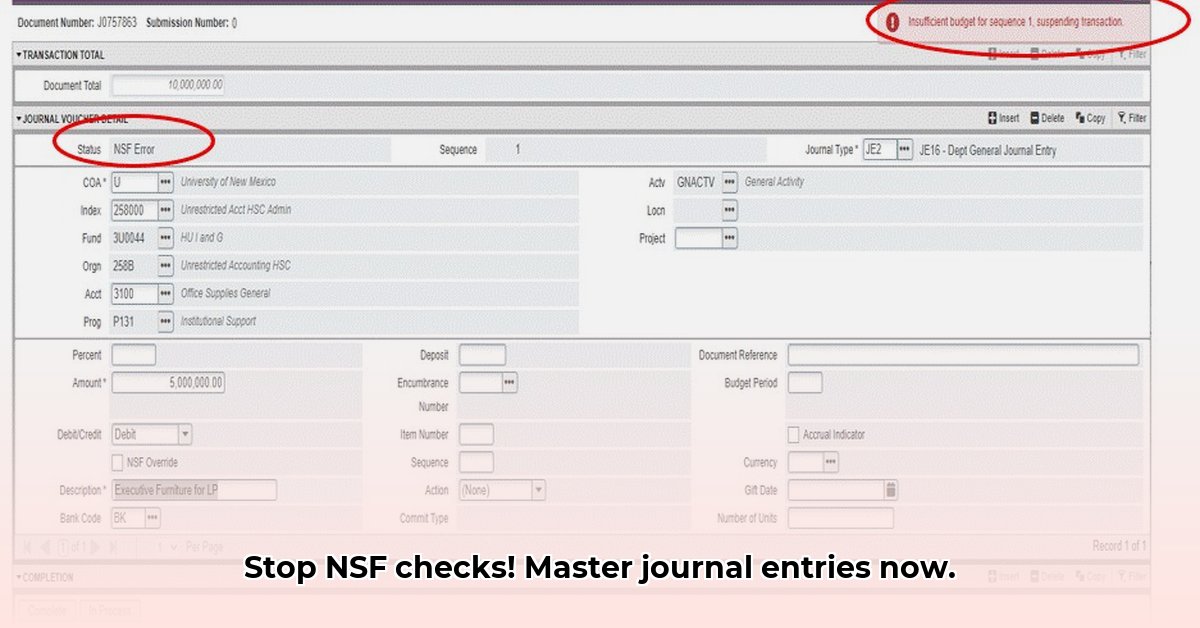
Dealing with a bounced check, or Non-Sufficient Funds (NSF) check, is a frustrating experience for any business. It disrupts cash flow, impacts client relationships, and requires careful accounting adjustments. This guide provides a step-by-step approach to handling NSF checks, from the initial journal entry reversal to strategies for preventing future occurrences. By mastering these techniques, you can protect your business's financial health and minimize those costly headaches.
Understanding NSF Checks
An NSF check is simply a check that's returned by the bank because the payer's account lacked sufficient funds to cover the amount. This leaves your business not only without the expected funds but also facing bank fees for processing the bounced check. Given that roughly 1 in 20 checks bounces, what proactive steps can you take to mitigate this risk?
The NSF Journal Entry: A Step-by-Step Guide
Correctly handling the NSF journal entry is crucial for accurate financial reporting. Here's a detailed, actionable process:
Step 1: Reversing the Original Entry
- Locate the original journal entry recording the initial deposit of the NSF check. This entry will typically debit Cash and credit Accounts Receivable.
- Create a reversing entry. Debit Accounts Receivable (to increase the amount owed) and credit Cash (to decrease the cash balance). The amounts should match the original entry exactly. This removes the erroneously recorded cash.
Step 2: Recording the Bank Fee
- Banks charge a fee for processing NSF checks. This fee represents an expense for your business.
- Debit Bank Charges Expense (or a similar expense account) and credit Cash to reflect the fee charged by the bank.
Example Journal Entry:
| Account | Debit | Credit |
|---|---|---|
| Accounts Receivable | $200.00 | |
| Cash | $200.00 | |
| To reverse incorrect cash receipt | ||
| Bank Charges Expense | $25.00 | |
| Cash | $25.00 | |
| To record bank charge |
This example demonstrates the reversal of a $200 check and the recording of a $25 bank fee. Remember, accuracy is paramount; double-check all entries meticulously before finalizing. Consistent, careful bookkeeping is key.
Preventing NSF Checks: Proactive Strategies
Preventing NSF checks is far more efficient than dealing with their aftermath. Implementing these strategies can significantly reduce your risk:
Credit Checks: For new clients or high-value transactions, consider conducting credit checks to assess payment reliability. This preventative measure can save significant time and financial strain.
Diverse Payment Options: Offer various payment methods, including electronic transfers (ACH), credit cards, and online payment platforms. This caters to customer preferences and reduces reliance on checks.
Clear Payment Policies: Establish clear, well-communicated policies regarding late payments and returned checks. Enforce these consistently to establish expectations and deter late or insufficient payments. This proactive approach can substantially reduce the number of NSF checks you encounter.
Account Monitoring: Regularly review your accounts receivable to identify potentially problematic accounts showing signs of delinquency or potential payment issues. Early interventions can greatly reduce your risk.
Recovering NSF Check Fees
While prevention is ideal, sometimes NSF checks still occur. Here's how to effectively recover the fees:
Contact the Payer: Reach out to the payer immediately and professionally. Explain the situation, detail the amount owed (including fees), and offer convenient payment options. Prompt communication can often resolve the issue quickly.
Collections Agency: If direct communication fails, consider a collections agency. However, be aware that this incurs additional costs.
Legal Action: As a last resort, consult with an attorney about legal options for recovering funds, but this path is often costly and time-consuming. Prioritize communication and reasonable payment plans as first steps.
Key Takeaways
- Mastering the NSF journal entry process is vital for maintaining accurate financial records and avoiding potential discrepancies.
- Proactive strategies for preventing NSF checks are far more cost-effective than dealing with the consequences.
- Combining preventative measures with effective recovery strategies ensures a robust approach to managing NSF check situations.
- Regular review of your accounts receivable is crucial for early identification of problematic accounts and proactive intervention.
This comprehensive approach to handling NSF checks will help you navigate these challenging situations effectively, ultimately protecting the financial well-being of your business. Remember, careful planning and proactive measures are key to minimizing the disruption and stress associated with NSF checks.